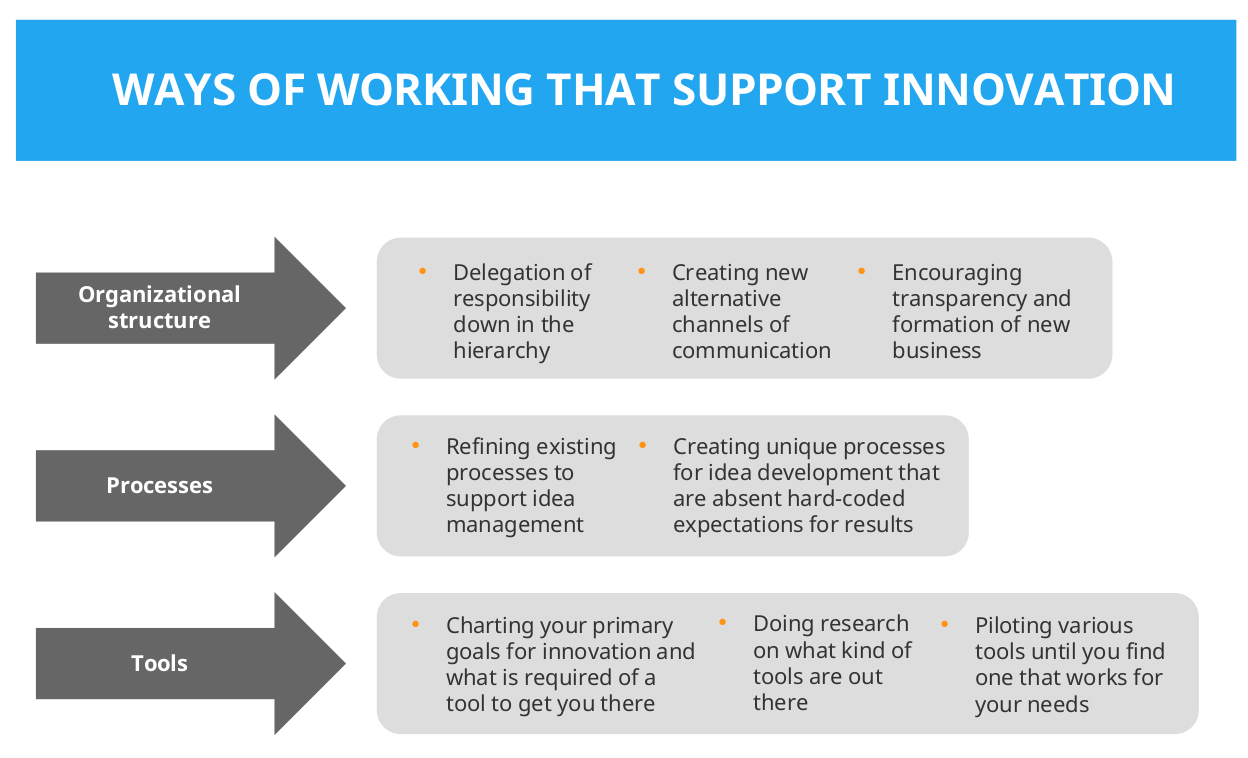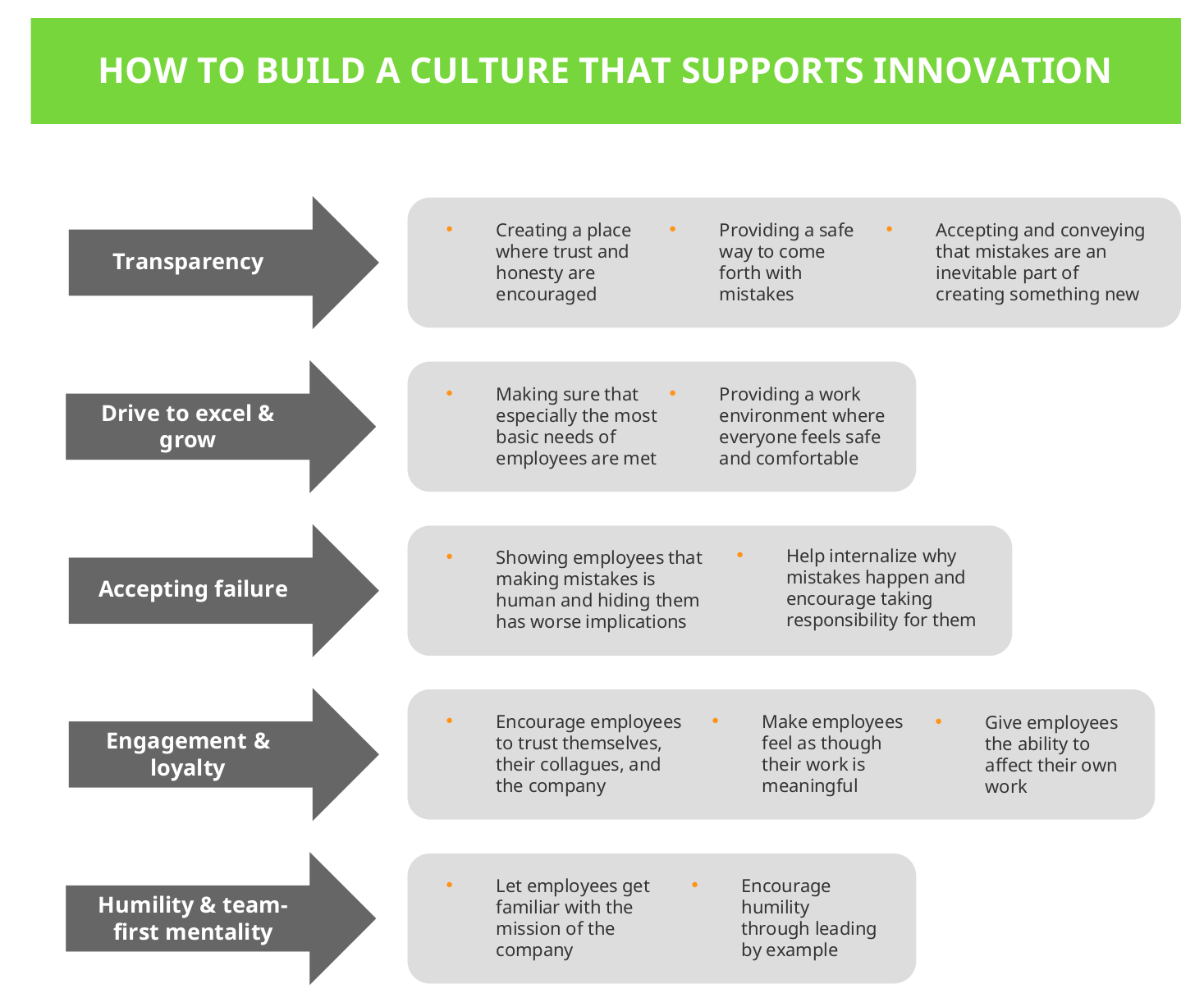Why Do Large Organizations With Creative People Fail in Innovation?
Everyone has the potential to be creative, it’s simply a matter of finding the right circumstances.
Why is it that many large organizations, despite having an overwhelming superiority in head count, seem to fail in being innovative when compared to smaller firms? Although it is something that leadership might brush off as: “Our employees are simply not very creative,” there are typically much larger underlying reasons that inhibit innovation.
In this post, we’ll give you our take on some of the common innovation pitfalls in organizations and show you what you can do to avoid them.

The two sides of a coin – Culture & ways of working
The difficulty in being innovative tends to grow in correlation with company size. This seems to defy logic. As the number of people in the company increases, so should the potential for great ideas which could ultimately end up being innovations. So, why the contradiction?
A renowned innovation enthusiast Henry Doss speculates in his Forbes article Why Big Business Fails At Innovation on how this dilemma of larger organizations may not be related to the traditionally stiff and conventional ways of working, but rather that these are just indisputable realities that “come with the territory.” He writes that the real reason could be the manifestation of deeper issues in business culture.
“So, yes, big businesses are constrained in very specific ways – technology, regulatory environment, capital, risk. But it’s not these real-world constraints that inhibit innovation. It’s business culture.”
– Henry Doss
Doss goes on to explain that in terms of business culture, attempts at optimizing and outsourcing innovation usually fail as for innovation to be successful, it must originate from where the action is; inside the organization. Instead of a “package deal” to be bought like a catering service, for innovation to be successful, it must be a part of the everyday activities on all levels of the company.
He does make a good point on the premise that business culture is the most commonly overlooked key factor in innovation. However, problems with the organization’s ways of working – such as inhibiting hierarchical processes, unwillingness to change or try something new, and overly cautious risk management - also play a very significant a role in making innovation happen.
According to Valuer.ai, encouraging creativity in the workplace is key to innovation. We also believe that business culture is not independent of the ways of working when it comes to innovation. Fixing one requires mending to the other.
From our experience, if you wish to alter how employees believe in their ability to impact their workplace and have their opinions listened to, along with having a culture that enables it, this change cannot take root without modifications to how especially the front line and middle management perceive company hierarchy.
Along with this, there need to be processes and tools in place for ensuring that ideas don't just remain watercooler gossip but will actually be collected and managed. But more on that later.
Ultimately, although business culture is the typical Achille’s heel of organizational innovation, a culture that celebrates ideation is simply not enough to turn ideas into actual innovations, let alone innovations into successful businesses.

Improving the System
Changing an organization’s culture and ways of working is not an easy feat, especially when it comes to larger entities.
In fact, many organizations dread significant change of just about all forms due to their dependency on efficiency, which drives incremental progress forward and allows investors their dividends. The only problem is that this ride is finite, with an expiration date written on the side.
Be it ten years or a hundred, if innovation isn’t an active exercise it’s only a matter of time until the game changes enough to push out the old players. History is riddled with this repetitive pattern as one company after another has fallen due to their inability to change.
On top of this, as company size increases, overhead tends to grow exponentially as more and more variables come into play. Thus, size ultimately becomes the very thing that resists growth with increasing intensity, ultimately even taking it to a complete halt.

So, how does one avoid succumbing to the same fate?
If we've learned anything from history, it's that the only way to reroute the train that's headed towards a cemetery of fallen titans is by consciously taking larger and larger risks in order find or create opportunities that aren't hindered by existing structures and processes. Now with risk I don't mean putting all eggs in a random basket and hoping for the best. I'm referring to the act of investing time and resources into something which is strategically thought through, but regardless has no guaranteed or immediate return on investment. This is something that especially larger organizations are very reluctant to do.
The only way to reroute the train that's headed towards a cemetery of fallen titans is by consciously taking larger risks to create opportunities that aren't hindered by existing structures and processes.
However, changes - such as adopting more risky ventures - must happen incrementally by taking steps into the right direction and building on what already is, instead of attempting sudden large changes that will likely get shot down in their infancy and ultimately discourage any future attempts.
The “bold” new initiatives could take place in smaller, independent and autonomous cells or units of the company, thus providing information on what works and what doesn’t. If suddenly game-changing ideas start spurting out of a unit of only 30 people, it’s a pretty good clue that something’s working.
Of course, this is not to say that radical changes aren’t necessary in some situations. For example, when a company has been backed into a corner and has to execute a “make it or break” decision. When the situation is dire enough, people know that they won't have another option and will simply adapt or leave.
But when making changes while there is still time to adapt to the changing economic landscape, it’s usually quite unrealistic to execute company-wide changes that carry any actual weight in the employee's mind.
The easiest option would be to do it all over again and this time do it “right”, but unfortunately you won't usually get that choice.

Refurbishing Foundations
When it comes to improving an organization to be more "innovation friendly", we must look at it from two angles. One is changing how the company is structured and how it does things in practice and the other sculpting how people are acting, or in other words, culture.
Now, let's first take a look at the ways of working.
Here are our key areas when it comes to improving the ways of working in a company:
- Organizational structure
- Processes
- Tools
Structure
A typical organizational structure seen in larger organizations is hierarchical due to its efficiency and manageability. However, it is very unyielding and thus limiting in terms of innovation. The problem is that the front line, which typically includes a vast majority of the employees in a company, gets easily ignored.
The are several reasons for this. For one, a hierarchical structure filters information flow, which can easily cause bottlenecks for innovation in the middle management.
Second, company development (read, “ideation”) isn't often included in the job description of your everyday “worker bee”. Thus, if you want ideas from the front line – as you most likely should – the process needs to be facilitated in a very intuitive and empowering manner.
Third, when the management has long neglected the ideas and input of the front line, it has instituted a mentality that their input is neither required nor wanted, which results in both parties having a problematic mindset.
Unfortunately, fixing these problems is no easier than understanding their origins.
However, a good place to start is at the common root of the problems; a decrease in the responsibility for decision-making the lower you go in the hierarchy.
Instead of leadership making all decisions – big or small – regarding new initiatives, ways of working, processes, and changes of any kind really, they should channel their focus on the “big picture” stuff and delegate responsibility of smaller decisions lower in the hierarchy.
This would not only make it possible for middle management to take initiative for innovation regarding the front line and their own job, but also free up significant resources in the leadership to focus on the big picture, as well as on supporting and empowering their teams.
Also, when decision-making is brought “down” in the hierarchy, it will ultimately be closer to the ones that the decisions really affect the most.
This, in turn, has many positive implications to consider:
- The decisions will be based on reality, not assumptions
- The decisions that are made will often be better and more practical
- The decision-making process will be faster and more efficient
- Employees will get more engaged and involved in future development
After responsibilities have been refocused, it’s easy to go on from there and start building new and better working methods and channels of communication between different levels of the organization, thus encouraging transparency and formation of new business, all the while further reducing the risk of forming innovation bottlenecks.

Processes
The reason that terms “innovation” and “process” are often spoken in the same sentence is that the right processes are necessary, if not vital, for innovation to flourish.
They work as the oil in the engine that makes systematic development of ideas into actual innovations possible. Without them to support your innovation management, you’ll likely have as many ideas floating about, but only a few of them ever turn into something useful.
Now, the issue with processes – especially in larger organizations – is that they often either inhibit innovation or fail to support it adequately. What this means is that innovation simply doesn’t have room to breathe when all systems are built on the notions of predictability, deadlines, and optimization.
If everything is viewed through the goggles of “how to maximize efficiency while minimizing risk”, it is nearly impossible to create something radical or disruptive. Of course, it is a “necessary evil”, to a degree, since big companies are dependent on efficiency in order to combat size-induced entropy.
However, efficiency-thinking should rarely be the cornerstone of an innovation strategy.
In our experience, to combat efficiency-thinking, in addition to refining inhibiting processes into ones that actually support idea management and development, there need to be additional ways of working that are devoid of hard-coded expectations for quantifiable results on day one – although still guided by an underlying intent or purpose. This gives breathing room for ideas to generate and progress along their natural course.
Tools
Finally, many organizations are missing the correct tools to help manage innovation, improve communication, and engage employees.
Good communication and employee engagement are generally important as they, in turn, further promote innovation.
Optimally one tool can be used for more than one of the aforementioned purposes. However, the most important thing is to have the right tools for the job.
It’s important to remember that no tool can magically generate ideas and turn them into innovations, regardless of what some vendors out there may promise.
Ultimately, it always comes down to having the right processes and ways of working to nurture innovation.
By having the necessary requirements on your part to “make innovation happen”, the right tool will make it possible. But if you have no interest or effort to put towards innovation, there is no tool that can innovate for you.
So how do you actually choose the tool(s)?
In a nutshell, the process would be following:
- Chart your own goals and understand what you hope to accomplish with the tool
- Do research on different idea management vendors, their tools, and what they have to offer
- Compare and shortlist the most promising candidates
- Pilot the software until you find one that works for your needs
However, there are also many other aspects to consider before making your final decision, so I recommend you read this extensive post on how to choose the right idea management software for further information.

Sculpting the Culture
Changing the more tangible aspects (structure, processes, tools) is one thing, but molding the culture to be more open towards innovation is another completely.
As spearheads for aspiring towards a more “innovation friendly” culture, we would put emphasis on the following aspects:
- Transparency
- Drive to excel & grow (personally and as a company)
- Accepting failure
- Engagement & loyalty
- Humility & team-first mentality
Transparency, as mentioned before, is the byproduct of increasing communication and thus reducing the negative side-effects of inhibiting organizational structures. However, it is also something that should be aspired towards through other conscious efforts as well.
So why is transparency – especially in larger organizations – often seen as a threat to information or job security, as well as focus?
There may be some truth to the notion of information security, but also towards focus. With an increase in transparency, the focus on specific tasks is bound to take a small hit, but the increased knowledge more than makes up for it in real productivity.
The positive implications, however, far outweigh the negative. Transparency in communication is one of the cornerstones of innovation as it makes sharing ideas, thoughts and other tacit knowledge possible.
So, are there other ways to induce transparency other than communication tools & channels?
Ultimately, it comes down to creating an environment where trust and honesty are celebrated. One way to do this is by giving employees a safe way to come forth with mistakes, issues, and concerns, and rewarding employees for that instead of them having to fear punishment. This conveys a message of acceptance and humility.
Mistakes and failures are an inevitable part of the process when working on creating something new and is nothing to be ashamed of.
Drive to excel & grow comes from an innate desire to improve yourself and others around you. A person with a desire for self-improvement has the will and need to become their best version, be that at home or the workplace, while also understanding the personal sacrifices that need to be made for the greater good.
This selfless ability or desire is difficult to promote with precision, as it is a very personal aspect. However, it is intertwined with a sense of purpose and the feeling that all areas in your life are functioning at a certain level. Thus, a good place to start is making sure everyone is feeling comfortable and accepted at the workplace and encouraging people to come talk about any personal problems. Sometimes even just being heard is enough.
Accepting failure does not only mean admitting it (as discussed in transparency) but also accepting that mistakes are a crucial part of the learning process. There is no human being alive who reached the “top” without making mistakes and learning from them.
You won't learn from mistakes if you deny their existence, but even more importantly, your colleagues won't either, so they are likely to repeat the same mistakes if you don't share yours.
Now, this is not the same as encouraging to take bold and unnecessary risks and claiming that it’s for personal growth. Mistakes don't need to be celebrated or encouraged. However, when they eventually happen, and they will happen, hiding them will only make things worse.
You should, instead, reverse engineer the said mistake as a team and aim to internalize the key points as to why it happened in the first place. Then encourage people to take responsibility and try to provide them with the help they need when they need it.

Engagement & Loyalty are important for getting everyone on the same page when it comes to the mission and agenda of the company. The “big picture stuff”.
If employees are engaged, they are determined to drive the company forward and thus focus on doing the right things instead of “just doing things” in general.
Loyal employees, on the other hand, form very strong attachments to things they hold dear. If this is aimed towards the company, it creates a sense of protectiveness. As to never harm the company in any way or stop others from doing so, along with a desire to do the right things for moving the company forward.
Both engagement and loyalty occur naturally if certain values are set at the core of company culture. These are the following:
- Trusting in themselves, colleagues, and the company in general
- Believing in what the company aspires to achieve (the mission of the company)
- Feeling that their work and input at the workplace is meaningful. That it matters, both for themselves and the company
- Knowing that they have a legitimate ability to affect their own work and a chance to get new opportunities
Humility & “team first”-mentality come from putting the needs of the organization or other people before your own, especially when it serves the greater good.
Now, this doesn’t mean throwing yourself onto embers, so others don’t burn their feet.
It simply means that your actions are not completely driven by selfish notions of “How does this serve me?” and “Do I feel like doing this?”, but rather such feelings are put aside in order to see the larger picture and understand how one’s acts can impact this greater good in a positive way. In the end, what's best for the organization, is usually best for the employees too.
For example, not taking credit for every project you contributed to in order to boast and promote your own ego, but rather letting others have their moment in the spotlight and gain self-confidence as this ultimately helps build a stronger team.
Both humility and a “team first”-mentality can be encouraged by allowing people to get familiar with the mission (provided that it's a meaningful one) of the company and to see why things and decisions are done the way they are.
Of course, humility can be a difficult trait to have for someone who's had a successful career, especially since humility often isn't, unfortunately, a requirement for a leadership position. However, humility can most certainly be learned and is something that we recommend every leader to practice.
The aforementioned cultural spearheads for innovation are not rules, but rather guidelines for how to promote such a culture. It’s important to remember that company culture is a large entity and that it consists of many smaller parts that all need to be built well and with the right intent.
After all, when many rivers flow into the same lake, it gets substantially larger. However, the lake can only be as large as the lowest edge allows it to be.
Thus, we recommend putting in the effort and incrementally starting to build a culture that is truly open for innovation, piece by piece.

A Story to End It
When I was a child, I threw a stone into a nearby pond and watched as the ripples spread out to the opposite shore. I thought to myself, “How far could they have gone, had the shore not been there?” Would they have just kept on going until an unknown entity disrupt them? Or would they simply fade away after moving their predetermined distance?
Of course, later I learned that by the laws of physics these ripples would go on infinitely, unless an opposing force slowed them down or stopped them completely.
But nothing stops me from throwing another stone.
The same applies when it comes to incremental change in an organization, be it in the smallest unit of the smallest branch. When you start creating ripples, they spread. They may get slowed down or stopped completely, but ultimately, they still push the motion forward.
The more you change, the more the change becomes you.
Keep throwing stones, for the next one’s ripples may just be able to reach the opposite shore.
Interested in Innovation and Leadership?
Subscribe to our blog to get the latest stories on innovation, leadership and culture straight to your inbox.







